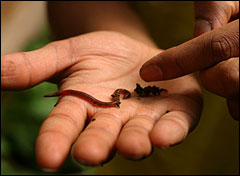Dear Umbra,
I recently moved into a studio apartment in an urban area. I used to compost in my backyard but don’t have that option anymore. I looked into getting a worm bin to use inside my apartment, but the cheapest ones seem to run around $200 and don’t hold very much. Can you recommend something for someone in a tight space, on a tight budget, that holds a lot of food scraps?
Lauren L.
St. Louis, Mo.
Dearest Lauren,
Red wiggler worms and their decompository companions make excellent compost, and a worm bin is pretty much the only choice for a snug, yardless apartment situation. Whether you can find one that both fits your apartment and accommodates oodles of food scraps remains to be seen. Cost, however, we can get around. A few plastic bins will do you just fine.
A worm bin is a shallow box filled with worm bedding, Eisenia foetida worms and other organisms, and unwanted human food. We put our food scraps into the bin, burying them in the bedding a little, and the micro- and macro-organisms scurry about, turning them into a lovely compost (detail on worm care can be found here). A well-managed worm bin will have almost no odor, because there is no anaerobic rot. There will be rot if the human adds more food than the worms can handle, and this limited capacity must be why worm bins have not taken the world by storm. There can be no other explanation.
The bin needs to be about a foot or two deep, dark, with drainage holes for the liquid compost and a lid. Plastic tubs from the hardware store are perfect — they come in various sizes, they’re cheap, and it’s easy to make holes in them. (But remember, no vinyl, that’s final!) You will need some way to catch the liquid as it emerges from the holes. Check out Seattle Tilth’s excellent, detailed “Off-the-shelf Worm Bin Plans” for a closed system consisting of two stacked plastic tubs and a spigot. It does require a shopping trip to the hardware store and a bit of assembly. If you just want to slap two tubs together, drill holes in the top one, and remember to regularly pour off the liquid from the bottom one, that will probably work.
Those of you with carpentry skills could also build a wooden worm bin (see Seattle Tilth’s “Worm Bin Plans“), or a trip to the thrift store might turn up a lidded wooden box that would be easily adapted. Don’t use a cedar box or any pressure-treated wood; both will be toxic to the wormies.
As to the size of the bin: A two foot-by-two foot box is supposedly big enough to handle about three and a half pounds of food scraps per week. I know, who weighs their food scraps? But give it a guess.
I don’t have the space to go into detail about worm bin care, so any readers setting out on their first wormy journey should read up about the bin, the bedding, feeding the worms, and extracting the compost. The internet is filled with excellent information, or read the classic book Worms Eat My Garbage, by Mary Appelhof. Start them out slow, give them time to build their numbers, and soon they will be merrily chomping along.
Foetidaly,
Umbra



